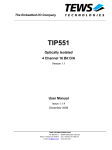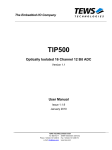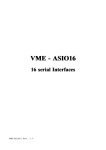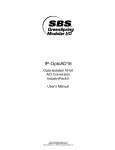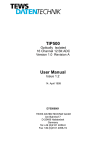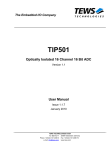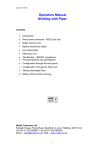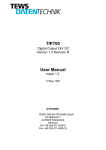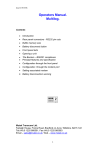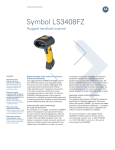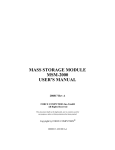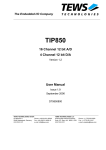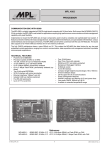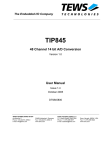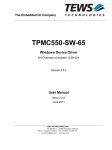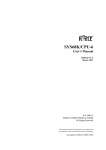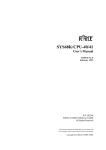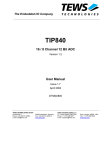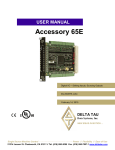Download TIP551 User Manual
Transcript
TIP551 Optically Isolated 4 Channel 16 Bit D/A Version 1.0 Revision A User Manual Issue 1.0 08. September 1997 D75551800 TEWS DATENTECHNIK GmbH Am Bahnhof 7 D-25469 Halstenbek Germany Tel +49 (0)4101 4058-0 Fax +49 (0)4101 4058-19 7,3 8VHU 0DQXDO 9HUVLRQ TIP551-10 Optically isolated 4 channel 16 bit D/A 0V to 10V or +/-10V This document contains information, which is proprietary to TEWS DATENTECHNIK GmbH. Any reproduction without written permission is forbidden. TEWS DATENTECHNIK GmbH has made any effort to ensure that this manual is accurate and complete. However TEWS DATENTECHNIK GmbH reserves the right to change the product described in this document at any time without notice. This product has been designed to operate with IndustryPack compatible carriers. Connection to incompatible hardware is likely to cause serious damage. TEWS DATENTECHNIK GmbH is not liable for any damage arising out of the application or use of the device described herein. Issue Desscription Preliminary issue Issue 1.0 Date 20. Aug. 1997 08. Sep. 1997 K1997 by TEWS DATENTECHNIK GmbH IndustryPack is a registered trademark of GreenSpring Computers, Inc 7,3 8VHU 0DQXDO 9HUVLRQ 1. Product Description . . . . . . . . . . . . . . . . . . . . . . . . . . . . . . . 1 2. Technical Specification . . . . . . . . . . . . . . . . . . . . . . . . . . . . 2 3. Functional Description . . . . . . . . . . . . . . . . . . . . . . . . . . . . . 3 3.1. Analog Output . . . . . . . . . . . . . . . . . . . . . . . . . . . . . . . . . . . . . . . . . . . 3.2. Data Correction . . . . . . . . . . . . . . . . . . . . . . . . . . . . . . . . . . . . . . . . . . . 3.2.1. DAC Correction Formula for 0V - 10V Output Range . . . . . . . . . 3.2.2. DAC Correction Formula for ±10V Output Range . . . . . . . . . . . . . 3 3 4 4 4. ID Prom Contents . . . . . . . . . . . . . . . . . . . . . . . . . . . . . . . . . . 5 4.1. ID PROM Contents TIP551-10 V1.0 . . . . . . . . . . . . . . . . . . . . . . . . 5 5. IP Addressing . . . . . . . . . . . . . . . . . . . . . . . . . . . . . . . . . . . . . 6 5.1. Channel Select Register Address $01 . . . . . . . . . . . . . . . . . . . . . . . 5.1.1. Output Channel Selection . . . . . . . . . . . . . . . . . . . . . . . . . . . . . . . . . 5.1.2. Automatic Load Bit . . . . . . . . . . . . . . . . . . . . . . . . . . . . . . . . . . . . . . . 5.2. Status Register Address $03 . . . . . . . . . . . . . . . . . . . . . . . . . . . . . . . 5.2.1. DACBUSY . . . . . . . . . . . . . . . . . . . . . . . . . . . . . . . . . . . . . . . . . . . . . . 5.2.2. VR Voltage Range . . . . . . . . . . . . . . . . . . . . . . . . . . . . . . . . . . . . . . . 5.2.3. ERROR . . . . . . . . . . . . . . . . . . . . . . . . . . . . . . . . . . . . . . . . . . . . . . . . 5.3. Data Register Address $04 . . . . . . . . . . . . . . . . . . . . . . . . . . . . . . . . . 5.4. Load Register Address $07 . . . . . . . . . . . . . . . . . . . . . . . . . . . . . . . . . 7 7 7 8 8 8 8 9 9 6. Analog Output Code . . . . . . . . . . . . . . . . . . . . . . . . . . . . . . . 10 6.1. Bipolar Output Code . . . . . . . . . . . . . . . . . . . . . . . . . . . . . . . . . . . . . . 6.2. Unipolar Output Code . . . . . . . . . . . . . . . . . . . . . . . . . . . . . . . . . . . . . 10 10 7. Jumper Configuration . . . . . . . . . . . . . . . . . . . . . . . . . . . . . . 11 8. IP I/O connector . . . . . . . . . . . . . . . . . . . . . . . . . . . . . . . . . . . . 12 8.1. Analog Output Connections . . . . . . . . . . . . . . . . . . . . . . . . . . . . . . . . 8.2. Power Input Connections . . . . . . . . . . . . . . . . . . . . . . . . . . . . . . . . . . 12 13 7,3 8VHU 0DQXDO 9HUVLRQ Figure 1: TIP551 Block Diagram . . . . . . . . . . . . . . . . . . . . . . . . . . . . . . . . . Figure 2: ID PROM Contents TIP551-10 V1.0 . . . . . . . . . . . . . . . . . . . . . Figure 3: CHANSEL Channel Select Register . . . . . . . . . . . . . . . . . . . . . Figure 4: Output Channel Select Table . . . . . . . . . . . . . . . . . . . . . . . . . . . Figure 5: STATREG Status Register . . . . . . . . . . . . . . . . . . . . . . . . . . . . . Figure 6: DATAREG Data Register . . . . . . . . . . . . . . . . . . . . . . . . . . . . . . . Figure 7: TIP551 Jumper Configuration for Voltage Ranges . . . . . . . . . Figure 8: TIP551 Analog Output Connections . . . . . . . . . . . . . . . . . . . . Figure 9: TIP551 Power Input Connections . . . . . . . . . . . . . . . . . . . . . . . 7,3 8VHU 0DQXDO 9HUVLRQ 1 5 7 7 8 9 11 12 13 1. Product Description The TIP551 is an IndustryPack9 compatible module with four 16 bit D/A channels which are galvanically isolated from the IndustryPack logic interface. Output voltage ranges of ±10 V or 0 V to 10 V are selectable by jumper for the four D/A channels. After RESET all D/A channels default to 0V. ,' 3520 ELW '$& ELW '$& ELW '$& '& '& ELW '$& ,QGXVWU\3DFN ,2 LQWHUIDFH &RQWURO ,QWHUIDFH RSWRFRXSOHUV ,QGXVWU\3DFN ORJLF LQWHUIDFH Each TIP551 is calibrated at the factory. Calibration information of the D/A channels is stored in the Identification PROM unique to each IP. FRQYHUWHU Figure 1: TIP551 Block Diagram 7,3 8VHU 0DQXDO 9HUVLRQ 2. Technical Specification Logic Interface IndustryPack9 Logic Interface Size single wide IP I/O Interface 50-conductor flat cable Analog Outputs 4 channels Isolation All D/A channels are galvanically isolated from the IP Interface Output Voltage Range ±10V or 0V to 10V, jumper selectable, common for all 4 channels Settling Time of DAC’s to 0.01% typ. 10 ³s Calibration Data Calibration data for gain and offset correction of each channel stored in ID PROM Output Current ±4mA for each channel Load Capacitance typical 1 nF Accuracy INL ± 4LSB typ. after calibration DNL ±0.5 LSB Monotonicity 16 bits over the specified temperature range Wait States IDSEL 1 wait state IOSEL 0 wait state Power Requirements 400mA @ 5V no load 430mA @ 5V with 4mA output current for each channel Temperature Range Operating -40EC to 85EC Storage -45EC to 125EC Humidity 5 - 95% non-condensing 7,3 8VHU 0DQXDO 9HUVLRQ 3. Functional Description 3.1. Analog Output The TIP551 includes 4 channels of analog outputs with a rtesolution of 16 bits and a voltage range of ±10V or 0V to 10V. The maximum output current for each channel is ±4mA. Each channel has a typical settling time to 0.01% of 10³s . Two voltage ranges are jumper selectable: ±10V or 0V to 10V. Voltage range selection covers all 4 channels. The 4 analog outputs of the TIP551 are galvanically isolated from the IndustryPack logic interface by optocoupler. On board DC/DC converters supply the power to the isolated part of the TIP551. 3.2. Data Correction There are two errors which affect the DC accuracy of the DAC. The first is the zero error (offset). For the DAC this is the data value required to produce a zero voltage output signal. This error is corrected by subtracting the known error from all readings. The second error is the gain error. Gain error is the difference between the ideal gain and the actual gain of the DAC. It is corrected by multiplying the data value by a correction factor. The data correction values are obtained during factory calibration and are stored in the modules individual version of the ID PROM. The DAC has a pair of offset and gain correction values for each single output channel. The correction values are stored in the ID PROM as two’s complement byte wide values in the range -32768 to 32767. For higher accuracy they are scaled to ¼ LSB. Because offset and gain correction values are dependent on the selected output voltage range the TIP551 has 2 different sets of ID PROM data. Depending on the jumper settings for the voltage range the corresponding set of correction values is automatically selected. 7,3 8VHU 0DQXDO 9HUVLRQ 3.2.1. DAC Correction Formula for 0V - 10V Output Range The basic formula for correcting unipolar DAC output value is: 'DWD 9DOXH *DLQFRUU 2IIVHWFRUU Data is the digital value that will be sent to the DAC, Value is the desired output value, Gaincorr and Offsetcorr are the correction factors from the ID PROM. 3.2.2. DAC Correction Formula for ±10V Output Range The basic formula for correcting bipolar DAC output value is: 'DWD 9DOXH *DLQFRUU 2IIVHWFRUU Data is the digital value that will be sent to the DAC, Value is the desired output value, Gaincorr and Offsetcorr are the correction factors from the ID PROM. Gaincorr and Offsetcorr correction factors are stored separately for each for the four DAC outputs. 1RWH )ORDWLQJ SRLQW DULWKPHWLFV RU VFDOHG LQWHJHU DULWKPHWLFV LV QHFHVVDU\ WR DYRLG URXQGLQJ HUURU ZKLOH FRPSXWLQJ DERYH IRUPXOD 7,3 8VHU 0DQXDO 9HUVLRQ 4. ID Prom Contents The Voltage Range bit of the DAC Status Register is used to select the correct set of ID PROM correction values and the output code. 4.1. ID PROM Contents TIP551-10 V1.0 ADDRESS FUNCTION $ 01 $ 03 $ 05 $ 07 $ 09 $ 0B $ 0D $ 0F $ 11 $ 13 $ 15 $ 17 ASCII ’I’ ASCII ’P’ ASCII ’A’ ASCII ’C’ Manufacturer ID Model Number Revision RESERVED Driver-ID low-byte $ 00 Driver-ID high-byte $ 00 number of bytes used $ 1D CRC $ 19 Version -10 $ 0A $ 1B $ 1D $ 1F $ 21 $ 23 $ 25 $ 27 $ 29 $ 2B $ 2D $ 2F $ 31 $ 33 $ 35 $ 37 $ 39 DAC1 Offset DAC1 Offset DAC2 Offset DAC2 Offset DAC3 Offset DAC3 Offset DAC4 Offset DAC4 Offset DAC1 Gain DAC1 Gain DAC2 Gain DAC2 Gain DAC3 Gain DAC3 Gain DAC4 Gain DAC4 Gain Ch.1 Low Byte Ch.1 High Byte Ch.2 Low Byte Ch.2 High Byte Ch.3 Low Byte Ch.3 High Byte Ch.4 Low Byte Ch.4 High Byte Ch.1 Low Byte Ch.1 High Byte Ch.2 Low Byte Ch.2 High Byte Ch.3 Low Byte Ch.3 High Byte Ch.4 Low Byte Ch.4 High Byte $ 49 $ 50 $ 41 $ 43 $ B3 $ 23 $ 10 $ 00 $ variable 7,3 8VHU 0DQXDO 9HUVLRQ $ board dependent $ board dependent $ board dependent $ board dependent $ board dependent $ board dependent $ board dependent $ board dependent $ board dependent $ board dependent $ board dependent $ board dependent $ board dependent $ board dependent $ board dependent $ board dependent ...... $ 3F Not used ....... $ 00 Figure 2: ID PROM Contents TIP551-10 V1.0 7,3 8VHU 0DQXDO 9HUVLRQ 5. IP Addressing The TIP551 is controlled by a set of registers, which are directly accessible in the I/O address space of the IP. All registers are automatically cleared by assertion of IP_RESET. ADDRESS NAME FUNCTION SIZE ACCESS $ 01 R/W $ 03 $ 04 $ 07 $ 09 R/W CHANSEL DAC Channel Select Register byte STATUS DATAREG LOADDAC IDWRENA DAC Status Register byte DAC Data Register word DAC Load Register byte ID Write Enable Register R/W R/W W byte 1RWH ,':5(1$ LV IRU IDFWRU\ XVH RQO\ GR QRW ZULWH WR WKLV UHJLVWHU 7,3 8VHU 0DQXDO 9HUVLRQ 5.1. Channel Select Register Address $01 The DAC Channel Select Register CHANSEL is used to select an output channel. This is done by writing the corresponding bit pattern into bit 0 to bit 1. A write access to the CHANSEL register starts the serial datatransfer to the DAC of the value stored in the DAC Data Register DATAREG. Be sure that the desired value is stored in the DATAREG before starting the conversion by writing to the DAC Channel Select Register CHANSEL. If Bit 7 is set to ’1’ a load signal is automatically generated after serial data transferto the desired DAC has completed. The load signal updates all 4 DAC’s with the value of the shift register of each DAC. Write accesses to the DAC Channel Select Register during DACBUSY active are ignored and set the ERROR flag in the DAC Status Register STATREG. $/ CS1 CS0 2XWSXW &KDQQHO 6HOHFWLRQ DOOZD\V UHDG DV ]HUR D ZULWH WR WKHVH ELWV KDV QR HIIHFW $XWRPDWLF /RDG DIWHU 'DWD 7UDQVIHU Figure 3: CHANSEL Channel Select Register 5.1.1. Output Channel Selection Bit 0 to bit 2 of the Channel Select Register are used to select the output channel of the TIP551. CS1 0 0 1 1 CS0 0 1 0 1 CHANNEL 1 2 3 4 Figure 4: Output Channel Select Table 5.1.2. Automatic Load Bit If bit 7 is set to ’1’ all 4 DAC’s are updated automatically after data transmition to the selected DAC channel. If bit 7 is set to ’0’ the user can update all DAC’s with a write access to the DAC Load Register immediatly or with the next channel selection with bit 7 is set to ’1’ after data transmition. 7,3 8VHU 0DQXDO 9HUVLRQ 5.2. Status Register Address $03 ERR VR DAC BUS Y '$& %86< IODJ 9ROWDJH 5DQJH IODJ (5525 IODJ HYHU\ ZULWH DFFHVV WR WKH 6WDWXV 5HJLVWHU FOHDUV WKLV ELW DOOZD\V UHDG DV ]HUR D ZULWH WR WKHVH ELWV KDV QR HIIHFW Figure 5: STATREG Status Register 5.2.1. DACBUSY Reading Bit 0 of the DAC Status Register STATREG as ‘1‘ indicates that a serial data transfer to the DAC is in progress. Write accesses to the DAC Channel Select Register CHANSEL during DACBUSY active are ignored and set the ERROR flag in the DAC Status Register STATREG. 5.2.2. VR Voltage Range Bit 1 of the DAC Status Register indicates the selected Voltage Range according to the jumper setting for the output voltage ranges of the TIP551. Reading bit 1 as ’0’ means +/- 10V output range and binary two‘s complement as output code , reading bit 1 as’1’ means 0V to 10V output range and straight binary as output code. 5.2.3. ERROR Write accesses to the DAC Channel Select Register CHANSEL or a write access to the DAC Load Register LOADREG during DACBUSY active are ignored and set the ERROR flag ( bit 2 ) in the DAC Status Register STATREG to ‘1‘. Any write access to the DAC Status Register STATREG clears the ERROR flag. 7,3 8VHU 0DQXDO 9HUVLRQ 5.3. Data Register Address $04 The DAC Data Register DATAREG is a 16 bit wide read/write register. The DAC Data Register contains the desired DAC value. A write access to the DAC Channel Select Register CHANSEL starts the serial data transfer to the DAC and if selected the conversion into an analog value. Now a new value can be written to the DAC Data Register DATAREG, or after transfer and conversion are completed ( DACBUSY = ‘0‘ ) the same value of the DAC Data Register can be written to another channel. The data of the DAC Data Register DATAREG are valid as long as they are not changed by a new write access to this register. To use the same value for another output channel just write the new channel to the DAC Channel Select Register. %LW '$& YDOXH Figure 6: DATAREG Data Register 1RWH )RU RXWSXW PRGH ORRN )LJXUH $QDORJ 2XWSXW &RGH 5.4. Load Register Address $07 The DAC Load Register LOADREG is a 8 bit wide write only register. Avery write access to the DAC Load Register updates all 4 DAC output’s with the last value writen into the DAC’s internal shiftregisters. Write accesses to the DAC Load Register LOADREG during DACBUSY active are ignored and set the ERROR flag in the DAC Status Register STATREG. 7,3 8VHU 0DQXDO 9HUVLRQ 6. Analog Output Code 6.1. Bipolar Output Code If the DAC channels are configured for +/- 10V output range by the corresponding jumpers the following analog output code is valid: '$7$5(* 287387 $7FFF + Full-Scale $8000 - Full-Scale $0000 Midscale 6.2. Unipolar Output Code If the DAC channels are configured for 0V to10V output range by the corresponding jumpers the following analog output code is valid: 7,3 8VHU 0DQXDO 9HUVLRQ '$7$5(* 287387 $FFFF $8000 $0000 Full-Scale Midscale Zero-Scale 7. Jumper Configuration The TIP551 must be configured by a 3 pin jumperfield for the desired output voltage range ±10V or 0V to 10V. See the following table for the corresponding jumper settings. The jumper seting is valid for all 4 DAC channels. Voltage range ±10V: J1 1-2 installed Voltage range J1 2-3 installed 0V to 10V: 3 2 1 ,2 ,QWHUIDFH ,3 /RJLF ,QWHUIDFH - Figure 7: TIP551 Jumper Configuration for Voltage Ranges 1RWH )DFWRU\ FRQILJXUDWLRQ LV WR 9 IRU DOO FKDQQHOV 7,3 8VHU 0DQXDO 9HUVLRQ 8. IP I/O connector 8.1. Analog Output Connections Pin-Number Signal 01 02 03 04 05 06 07 08 DAC output 1 AGND DAC output 2 AGND DAC output 3 AGND DAC output 4 AGND Figure 8: TIP551 Analog Output Connections 7,3 8VHU 0DQXDO 9HUVLRQ 8.2. Power Input Connections Pin-Number Function 44 45 46 47 48 49 50 AGND -15V AGND +15V AGND +5V AGND Figure 9: TIP551 Power Input Connections 1RWH 7KH SRZHU LQSXW FRQQHFWLRQV DUH UHVHUYHG IRU VSHFLDO YHUVLRQV RI WKH 7,3 ZLWKRXW RQ ERDUG '&'& FRQYHUWHU 'R QRW VXSSO\ DQ\ YROWDJH WR WKHVH SLQV IRU WKH 7,3 YHUVLRQ 7,3 8VHU 0DQXDO 9HUVLRQ



















